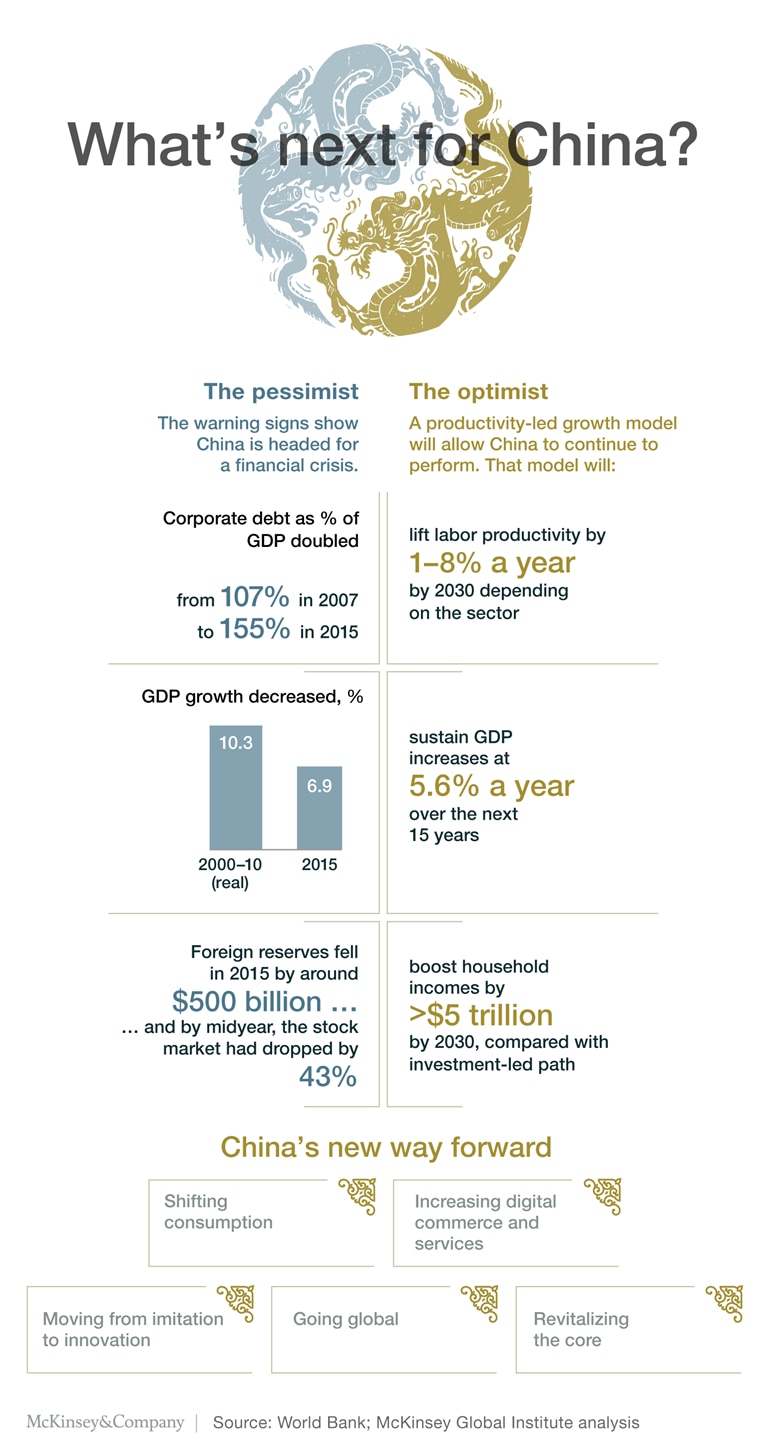For ten years or more, China has been a uniquely powerful engine of the global economy, regularly posting high single-figure or even double-digit annual increases in GDP. More recently, growth has slowed, prompting sharp falls in international commodity prices and casting a shadow over the near-term prospects for developed and emerging markets.
What will happen next? Pessimists struggle to see what China can do for an encore after what they say was an extraordinary, one-off period of catching up. Optimists believe that during the next 10 to 15 years, China has the potential to continue to outperform the rest of the world and to take its place as a full-fledged advanced economy (see summary infographic, “What’s next for China?”).

While most observers look at China at the national or, at most, the sector level, recent research from the McKinsey Global Institute (MGI) analyzes more than two thousand companies in order to identify a set of opportunities for policy makers and business to speed up the transition. This CEO guide discusses this and other recent research to help executives plot their course in China’s fast-changing economic landscape.
A new growth model
Front and center in any discussion about China these days are concerns about the country’s economy. Last year, GDP and employment growth dipped to the lowest levels in 25 years, corporate debt continued to soar, foreign reserves fell by around $500 billion, and by mid-2015 the stock market had dropped by 43 percent—all signs, pessimists say, that China could be on track for a financial crisis.
For those reasons, nearly everyone, including the Chinese government itself, recognizes that China’s investment-led economic model, for all its accomplishments, has to change—and soon. Capital productivity and corporate returns are falling. And MGI’s stress-test analysis finds that the amount of nonperforming loans could reach 15 percent in 2019, from today’s official figure of 1.7 percent. While a worsening of that figure would not necessarily lead to a systemic banking crisis, the collateral damage would likely include a substantial and unnecessary slowdown in growth.
The opportunities identified by MGI have, according to its estimates, the potential to lift labor productivity by 1 to 8 percent per year depending on the sector, boost household incomes by more than $5 trillion by 2030 compared with the current investment-led path, and sustain GDP increases at 5.6 percent per annum over the next 15 years (Exhibit 1). Whether China will realize that potential depends in part on the ability of China’s leading companies to generate and meet demand, raise productivity, and create value through the means described below. Certainly, sufficient financial capital exists for them to do so, even absent the politically less palatable (and therefore less likely) rationalization of excess economic capacity (for instance, in coal and steel) that would raise longer-term prospects even as it caused shorter-term job losses.

Realizing these transitional opportunities isn’t a foregone conclusion. To no small degree, they require the help of government policy makers. But they’re likely to get an organic boost, too, as the forces of capitalism motivate the combined efforts of locally owned and multinational companies alike. By unleashing the power of China’s consumers and its corporate sector, a productivity-led model for growth is likely to create a new context for the companies that compete there.
The consumption shift
First and foremost, perhaps, the transition to advanced-economy status requires stoking and meeting demand from China’s emerging middle class, whose spending is now only 5 to 20 percent of what it is in most advanced economies. To be sure, this group is enormous. MGI recently put the opportunity in perspective, citing China’s working-age consumers (15–59 year-olds) as one of three groups that will drive roughly half the increase in global consumption between now and 2030. (The other two are retirees in the developed world, and 15–59 year-olds in North America.)
Already, there are signs of a growing propensity to spend more and save less. McKinsey’s 2016 global sentiment survey, for instance, found that China’s working-age consumers, compared with peers in other regions, are most inclined to prioritize spending over saving or paying off debt. As they spend more, they are also likely to broaden their patterns of consumption, which are currently limited by the quality and variety of Chinese goods and services. In fact, Chinese consumers are increasingly trading up from mass products to premium products. A McKinsey research effort encompassing 10,000 in-person interviews with people aged 18–56 across 44 cities found that 50 percent now seek the best and most expensive offering, a significant increase over previous years (Exhibit 2).

The implication for CEOs is clear: recognize China’s consumer potential and try to get ahead of the curve in meeting the demand. Some companies may need to beef up the research arm of their sales and marketing organizations. Others may require more sophisticated data analytics to inform their research. Still others will want to focus on delivery of exceptional customer experiences to set themselves apart from their competitors.
The digital effect
As China makes its transition, the impact of digital technologies on the evolution of commerce, the service sector, and talent management will be profound.
Digitizing commerce
China’s massive online community—nearly 690 million Internet users (as of December 2015) and 700 million smartphone users—provides promising ways to identify and meet latent consumer demand. McKinsey’s most recent survey of Chinese Internet users1 indicates the main potential for the growth of e-commerce is in cities classified, by population, as Tier 3 and below. While online consumer spending in lower-tier cities caught up with spending in high-tier ones for the first time in 2015, some 160 million people in low-tier cities who use online services in other ways have yet to begin online shopping. That’s nearly as many as the number of online shoppers in high-tier cities today.
Making the most of that opportunity will require e-commerce players in China to follow the data-analytics practices of leading digital retailers in Europe and the United States to improve customer retention and stimulate consumption. Skills in social media are also gaining importance as more and more Chinese consumers make it a significant channel for deciding what to buy and for acting on those decisions.
Of the WeChat users in a recent McKinsey survey, for example, 31 percent initiated purchases on the platform—double the proportion of the previous year (Exhibit 3).

Digitizing the service sector
Digital technologies can also boost productivity in China’s service sectors while raising the skills of the labor force to fill China’s talent gap and sustain labor mobility. Many of the country’s service sectors including retail, logistics, and healthcare have very low productivity compared with their counterparts in other countries. Retailers can use digital technology to enable the operations of modern-format physical stores such as big-box discount stores and improve the efficiency of existing businesses through better supply-chain management. E-commerce platforms can help retailers reach Tier 2 and Tier 3 cities, where the cost of building physical stores is prohibitive. Digital platforms for scheduling can make the 700,000 companies in the logistics sector far more efficient. In the social-services sector, investment in online-learning platforms can reduce disparities in urban and rural education even as telemedicine systems enable doctors in cities to treat patients remotely in rural health clinics.
From imitation to innovation
China’s ambition to go from absorbing and adapting global technologies to being an innovation leader is a key plank of the productivity-led model. A McKinsey Global Institute report in October 2015 set out the case, showing the potential to carve out a world-leading position in pharmaceuticals, semiconductors, and communications equipment in the way that it has done in high-speed rail and wind turbines (global revenue shares of 41 percent and 20 percent, respectively).
McKinsey synthesis of publicly available data about prominent Chinese companies and big multinational companies active there highlights the extent to which China is already an important center of innovation. The numbers show that R&D spending in China rose by 120 percent between 2007 and 2015 and is expected to accelerate over the next five years, across a variety of industries, as companies expand their design centers (Exhibit 4).2 The challenge for many China-based design centers will be to move from a focus on making products for local markets to developing innovative new products for global markets.

But China appears to be ahead of the game in at least two areas: the pace of innovation and the quality of the mobile experience there, and the use of geolocation, according to the former president of Amazon China, Doug Gurr. “There’s very little mapping in China, and there are many areas with no street addresses, but China has solved these logistics problems with geolocation,” says Gurr. “You wouldn’t have thought you’d see bicycle rickshaws with better point-to-point geolocation and better GPS-enabled devices than you see anywhere else in the world. It’s amazing and exciting—there’s a blend of rough, old-fashioned ways of doing things coupled with technology that is way ahead in terms of the use of data informatics.”
The willingness of Chinese consumers to buy innovative products may quicken China’s shift from imitation to innovation. A recent McKinsey survey of more than 3,500 Chinese consumers, for example, found that a majority of electric vehicle (EV) owners in China is keen to buy EVs again, and the proportion of consumers who say they are interested in buying an EV has tripled since 2011.
As China ups its innovation game, CEOs globally will have to focus on faster, cheaper, and more global R&D with a stronger role for China. They should consider taking bigger bets on their China research platform and to accelerate their pace of project development to match local competitors. Leveraging Chinese talent will be a critical R&D success factor globally.
Global thrusts
While Chinese companies have become major global players in some industries by virtue of their shares of the massive China market, many Chinese companies have not yet started to do business around the world. China is second only to the United States with 110 companies in the Fortune Global 500, but the vast majority of Chinese companies on the list are largely domestic businesses in construction, infrastructure, energy, and finance. Many are asset-heavy operations and resource monopolies operating entirely in China, and 80 percent are state-owned enterprises. (One exception to the rule is Tencent, which recently agreed to buy most of Supercell, the Finnish video-gaming company that developed the widely played Clash of Clans game.)
The opportunity for Chinese companies to accelerate their growth outside of China can get a boost from the One Belt, One Road initiative, as discussed by McKinsey’s Kevin Sneader in a recent video commentary.
One Belt, One Road is a development strategy to link China with countries in Africa, Asia, and Europe. The Chinese government is budgeting close to $1 trillion for the initiative through state financial institutions and state-owned enterprises’ global projects.3 The extent to which multinational companies believe Chinese companies will be successful going global will inform the degree to which they prepare, in their own markets and geographies, for competitive intensity to increase.
Leaning out and automating
In parallel with shifts in consumption, digitization, innovation, and globalization, Chinese companies, like their peers in the West, must keep a close eye on operational excellence and automation.
Across services and manufacturing, labor productivity in China remains just 15 to 30 percent of advanced-economy levels. Approaches such as lean and Six Sigma are not new to China, but they have had limited impact due to a focus on technical tools and too little attention paid to helping workers embrace and adapt to new processes.
That said, China also has a significant opportunity to introduce more automation into manufacturing. Even though China is the largest market for robots in the world, Chinese companies remain relatively unautomated, with only 36 robots per 10,000 manufacturing workers, about half the average of all advanced economies and less than one-fifth the US level (Exhibit 5).

In China, where wages are still low (at least relative to Western economies), CEOs will want to examine carefully the economic case for automation. Recent MGI research indicates that the majority of benefits from automation may come not from reducing labor costs but from raising productivity through fewer errors, higher output, and improved quality, safety, and speed.
China may be at a crossroads, but if the country succeeds in its transition to a productivity-driven growth model—and to an advanced economy—a fresh set of opportunities and challenges for businesses operating in China, and for the companies that compete with them, will surely emerge.


